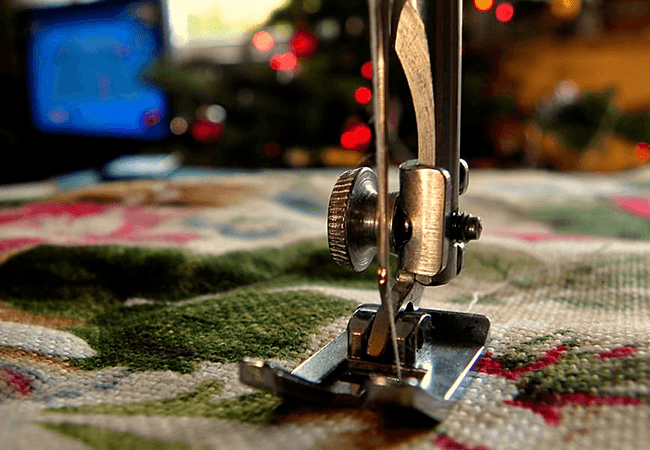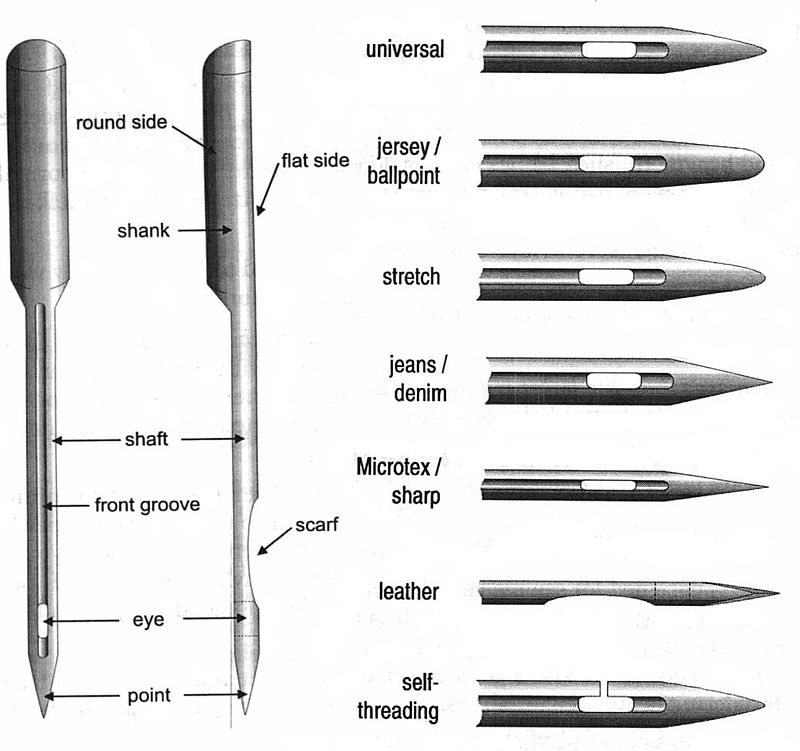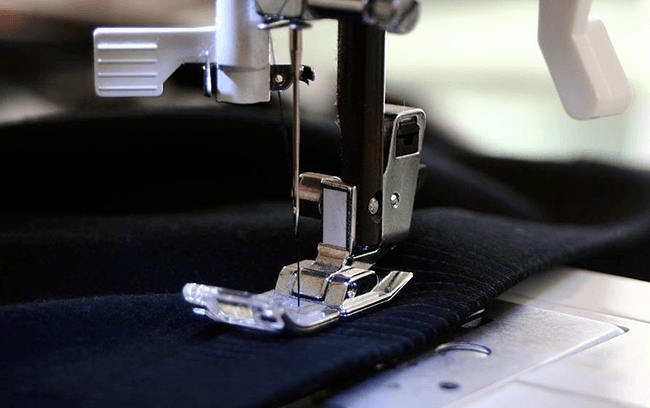One question we hear time and time again — especially from newbie sewers — is what sewing machine needle to use?
There are a surprising number of needles you you’ll likely come across when using your sewing machine — especially if you plan on clothes making.
One thing that can be intimidating for beginners is choosing the right set of needles and when to use them.
Here we have a quick sewing machine needle guide to help get you on your way to perfecting your craft.
Sewing Machine Needle Size Guide

Different Parts of the Machine Needle
It is good to know how the sewing needle does its job and how it interacts with the fabric and the machine.
The design of the sewing machine needle is surprisingly complicated if you look at it closely. Here is a quick reference for all the components of the sewing needle.
- Point: The tip of the needle that is used to pierce the material.
- Eye: A hole where the thread is threaded through.
- Scarf: A thin point in the shaft which allows the bobbin/shuttle to pass.
- Front Groove: A cut down the length of the shaft that releases the thread into a loop shape for the bobbin/shuttle to grab.
- Shaft: The length of the needle that drives the eye and thread through the material.
- Shank: Where the needle is attached to the sewing machine.

What Sewing Machine Needle To Use?
Say we are working on a project with our Singer machine and have a variety of Singer sewing machine needles.
It is very important that we choose the right one for the job to avoid damaging the fabric.
When you are selecting your sewing needles, it’s important to first identify the material you will use and the type of needle you will need, since that will drastically affect the look and quality of your final result.
Then you have to consider the sewing machine needle sizes you will need, depending on the thickness of the fabric and the thread you are using, to keep from harming the material.
See: Singer’s sizing chart for different types of fabrics.
Take a look at this list of the types of sewing needles you may encounter.

Universal Needle
The universal needle lives up to its name: it’s a general purpose needle which you can use for most projects.
Because it has a slightly rounded tip that isn’t too sharp, it pushes through the material rather than piercing it, making it good for woven fabrics.
We use it to mend things like t-shirts, but it isn’t good for finely detailed work nor thick fabrics like denim.
Jersey/Ballpoint Needle
The Jersey needle is what you will use for closely knitted and tightly woven fabrics.
It has a medium ballpoint tip that allows it to separate the fibers and slip through the spaces without damaging them.
It is good for making even stitches for heavy knits, but can also be used for spandex and other stretchy fabrics.
Stretch Needle
The stretch needle is specially used for light weight knits, spandex, and other stretchy fabrics.
It has a slightly rounded tip to prevent the needle from skipping stitches.
Denim Needle
This needle is what you will use to tailor your denim wear.
It has a sharp point and small eye to penetrate the thick fabric layers.
Microtex/Sharp Needle
It’s a thin, sharp needle that is used to cut through materials like finely woven fabrics such as silk and microfiber fabrics.
It is perfect for heirloom stitching, because it is great at making straight stitches.
Leather Needle
A needle for tailoring leather, suede, and other thick nonwovens.
It has a triangular point to cut a clean hole in the leather. When you sew leather, remember to stitch carefully because the holes are permanent.
Embroidery Needle
As the name implies, this needle is used for embroidery.
It has a larger eye than the universal needle to contain the embroidery thread and a large-groove scarf to protect the thread and prevent skipping.
Metallic Needle
The metallic needle is used for metallic threads and is ideal for embroidering designs into fabrics.
It features a larger eye than the embroidery needle and a teflon coating to prevent shredding.
Wing Needle
This needle is so named for it winged eye area that helps keep the fabric open.
You will use the wing needle for heirloom stitching, hemming, and decorative finishes in tightly woven fabrics.
Quilting Needle
The quilting needle has a tapered point and is strong enough to pierce the layers of a quilt.
It has a special shaft and eye to avoid shredding threads or fabrics. You will be using it to combine the pieces of a quilt together.
Serger Needle
This needle is good for the overlock stitch and is compatible with Serger sewing machines.
Double Needle
For when you need multiple needles on a single shaft, choose the twin/trio needle.
That’s what makes it good for decorative stitching and hemming.
Twin needles come in denim, stretch, and embroidery, while trio needles only come in universal. It is compatible with double needle sewing machines.
Which sewing machine needles do you use the most?
